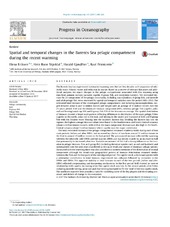| dc.description.abstract | The Barents Sea has experienced substantial warming over the last few decades with expansion of relatively warm Atlantic water and reduction in sea ice. Based on a review of relevant literature and additional analyses, we report changes in the pelagic compartment associated with this warming using data from autumn surveys (acoustic capelin, 0-group fish, and ecosystem surveys). We estimated biomass for 25 components of the pelagic community, including macroplankton, 0-group fish, and juvenile and adult pelagic fish, were examined for spatial and temporal variation over the period 1993-2013. The estimated total biomass of the investigated pelagic compartment, not including mesozooplankton, ranged between about 6 and 30 million tonnes wet weight with an average of 17 million tonnes over the 21-years period. Krill was the dominant biomass component (63%), whereas pelagic fish (capelin, polar cod and herring) made up 26% and 0-group fish 11% of the biomass on average. The spatial distribution of biomass showed a broad-scale pattern reflecting differences in distribution of the main pelagic fishes (capelin in the north, polar cod in the east, and herring in the south) and transport of krill and 0-group fish with the Atlantic water flowing into the southern Barents Sea. Dividing the Barents Sea into six regions, the highest average biomass values were found in the Southwestern and South-Central subareas (about 4 million tonnes in each), with krill as the main component. Biomass was also high in the North-Central subarea (about 3 million tonnes) where capelin was the major contributor. The total estimated biomass of the pelagic compartment remained relatively stable during each of two main periods (before and after 2004), but increased by a factor of two from around 11 million tonnes in the first to around 23 million tonnes in the last period. The pronounced increase reflected the warming between the relatively cold 1990s and the warmer 2000s and was driven mainly by an increase in krill due presumably to increased advection. Variable recruitment of fish had a strong influence on the variation in pelagic biomass, first as 0-group fish (including demersal species such as cod and haddock) and subsequently over the next years manifested as strong or weak year classes of dominant pelagic species. Associated with the warming there was also a northern or eastern extension of the distribution of several components although the broad-scale geographical pattern of biomass distribution remained similar between the first and the last parts of the investigated period. The capelin stock, a dominant species with a substantial contribution to total biomass, experienced two collapses followed by recoveries in the 1990s and 2000s. The apparent stability in total biomass in each of the two periods (before and after 2004) reflected compensating and dampening mechanisms. In the first period, krill showed an inverse relationship with capelin, increasing when the capelin stock was low. In the second period, other fishes including juvenile herring, polar cod and blue whiting increased to fill the ‘void’ of the low capelin stock. The syntheses reported here provides a basis for modelling some of the key players and dominating processes and drivers of change in the ecosystem. | en_US |

